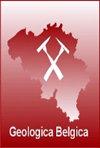加丹加铜带沉积层状矿床矿石分带的反应输运模拟及硫化铜共生
IF 0.7
4区 地球科学
Q2 GEOLOGY
引用次数: 3
摘要
1. 沉积层状铜矿的特点是包括几种硫化物和氧化物矿物,它们表现出不同的分带和共生作用。刚果民主共和国加丹加铜带层状铜矿成矿作用图1)发生在新元古代的加丹加超群,主要在Roan群,但也在Nguba和Kundelungu群。Nguba群位于Roan群之上,位于大砾岩的底部,这是一个冰川沉积物。Nguba集团隶属于Kundelungu集团,其基础是Petit集团。后者也是一个辉晶岩矿床(Cailteux et al., 2005)。在Roan群下部的矿山亚群中主要有两个矿体,即下矿体和上矿体。在这两个矿体之间,出现了一个贫瘠或弱矿化的成员,罗氏硅质纤维素(RSC)。两个矿体的寄主岩为白云质页岩、粉砂岩和叠层岩白云岩(Cailteux et al., 2005)。后者的页岩和粉砂岩含有硬石膏和极早成岩黄铁矿后的透镜状层和伪晶结核(Cailteux et al., 2005)。RSC最初被解释为块状叠层石白云岩和一些互层白云质粉砂岩,因此是生物成因的碳酸盐。图1所示。中非铜带的位置和最重要的矿床(在Cailteux et al. 2005之后)。号码本文章由计算机程序翻译,如有差异,请以英文原文为准。
Reactive transport modelling of ore mineral zoning and the paragenesis of copper sulfides in sediment-hosted stratiform ore deposits, the Katanga Copperbelt (DRC)
1. Introduction and geological settingSediment-hosted stratiform copper deposits are characterized by including several types of sulfide and oxide minerals that exhibit different zoning and paragenesis. Stratiform copper mineralization in the Katanga Copperbelt (Democratic Republic of Congo; Fig. 1) took place in the Neoproterozoic Katanga Supergroup, mainly in the Roan Group, but also in the Nguba and Kundelungu Groups. The Nguba Group overlies the Roan Group and consists at its base of the Grand Conglomerat, a glacial deposit. The Nguba Group is overlain by the Kundelungu Group, with the Petit Conglomerat at its base. The latter is also a diamictite deposit (Cailteux et al., 2005). Two main ore bodies are present in the Mines Subgroup in the lower part of the Roan Group, i.e. the Lower and Upper Orebody. Between both ore bodies, a barren or weakly mineralized member, the Roches Siliceuses Cellulaire (RSC), occurs. The host rock of the two ore bodies is formed by dolomitic shales, siltstones and stromatolitic dolomites (Cailteux et al., 2005). The latter shales and siltstones contain lenticular layers and nodules of pseudomorphs after anhydrite and very early diagenetic pyrite (Cailteux et al., 2005). The RSC is interpreted to originally represent massive stromatolitic dolomites with some interbedded dolomitic siltstone, and thus biogenic carbonates. Figure 1. Location of the Central African Copperbelt and of the most important ore deposits (after Cailteux et al. 2005).Numer
求助全文
通过发布文献求助,成功后即可免费获取论文全文。
去求助
来源期刊

Geologica Belgica
地学-地质学
CiteScore
4.70
自引率
27.80%
发文量
8
审稿时长
>12 weeks
期刊介绍:
Geologica Belgica is a Belgian journal that welcomes papers concerning all aspects of the earth sciences, with a particular emphasis on the regional geology of Belgium, North West Europe and central Africa. Papers not dedicated to the geology of Belgium, North West Europe and central Africa are only accepted when one of the authors is linked to a Belgian University or Institution. Thematic issues are highly appreciated. In this case, guest editors take in charge the selection of the manuscripts and the subject of the papers can be enlarged. The journal is in open access.
Submitted manuscripts should be concise, presenting material not previously published. The journal also encourages the publication of papers from Belgian junior authors. Short letters are accepted. Papers written in English are preferred. Each mansucript will be reviewed by at least two reviewers.
 求助内容:
求助内容: 应助结果提醒方式:
应助结果提醒方式:


